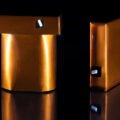Ever since humans landed on the Moon, we’ve wondered if the time would ever come for us to explore it and possibly even colonize it. Faced with challenging environmental conditions, we would have to overcome the lack of oxygen, food, water, energy, and we would have to find a way to build a shelter.
Dealing with all of these obstacles would require a lot of resources. Bringing them with us from Earth would be very expensive so, what if we could take advantage of all the resources the Moon has to offer?
Here are five ways we can mine the Moon and begin a complete shift to going “off-world.”
Mining for water
NASA reported that considerable evidence of water ice has been observed in the colder parts of the polar regions of the Moon. This indispensable resource has also been found on sunlit areas of the Moon in an amount that’s “roughly equivalent to a 12-ounce bottle of water in a cubic meter of lunar soil.”
This discovery is exciting for several reasons. The most immediate one is that readily available water means there are several locations available to build a moon base where people could live. That water could be used for drinking, growing plants, and hygiene purposes.
However, water could also be used to create rocket fuel. Water molecules (H2O) are made of hydrogen and oxygen, both of which are used in rocket propellants. The molecules could be split by electrolysis (running an electric current through the water) and then stored separately as liquids, ready to fuel a rocket.
Rockets would only need to carry enough fuel to make it to the Moon, where they could re-fuel before making their way to other places in space, meaning that this would be an opportunity to travel deeper into space at lower exploration costs.
Mining for Helium-3
Right now, there is an urgency in trying to find sustainable and cost-effective ways of generating energy that doesn’t use fossil fuels, and that is less damaging to the environment. A possible way to solve the problem would be extracting a helium variant, Helium-3, from the Moon.
Helium-3 is not extremely abundant on lunar soil (up to 20 parts per billion), but there’s a lot more of it on the Moon than on our planet because our atmosphere blocks it from reaching us through solar winds. This gas could theoretically be used to generate enormous amounts of energy through nuclear fusion reactions.
By fusing two of these atoms together under high temperature and pressure, we could obtain massive amounts of energy without the secondary radioactive by-product production (an advantage when compared with other fusion reactions) and greenhouse gas emissions.
Nuclear fusion powers the Sun and other stars, so you can imagine the amount of energy we could gather from this technology. We’re still many years away from actually trying to exercise these theories, plus we would have to think of a way to transport Helium-3 back to Earth successfully, but it’s good to know that we have a good reserve of this gas on the Moon, ready for the taking.
Mining the regolith for oxygen
The Moon’s atmosphere could never sustain oxygen-dependent beings like us. However, there’s plenty of oxygen on the Moon, just not as a gas. The Moon’s surface – the regolith – is made up of about 45% oxygen that is tightly bound into the rocks and minerals.
There’s a process we use here on Earth to produce aluminum. An electric current is passed through a liquid form of aluminum oxide that separates the aluminum from the oxygen. In this case, oxygen is the by-product, but on the Moon, it would be the other way around.
Using a sustainable energy source, like solar energy, this process would not only be an easy way to obtain oxygen for any lunar bases or other habitats, but it would also result in the accumulation of aluminum (or other metals) that could be used in buildings, aircraft, and medical devices.
Probing for Rare Earth Metals (REM)
The 15 lanthanides, plus scandium and yttrium, compose the 17 Rare Earth Metals (REM) used in modern electronics, batteries, renewables, and electric motors. 90% of our planet’s REM supply is produced in China, but they claim that their reserves might only last us 12 to 15 more years.
This justifies searching for these metals on the Moon and mining them on spots rich in potassium and phosphorous. If humans want to colonize and live on the Moon one day, they’ll have to innovate and create new machinery, and REM is vital to that process.
Mining Silicon
Silicon is pretty abundant on Earth, so why would it be important to find it on the Moon? This metalloid could have a wide variety of uses for future lunar settlers, and the fact that it makes up 20% of all lunar material means we wouldn’t have to bring it with us from Earth, leaving a lot more space for other resources that could be useful in space travels.
Silicon is incredibly important for constructing solar panel arrays which would probably be the best energy source to power lunar bases, outposts, and all machinery. It can also be used to create glass, fiberglass, and useful ceramics.
Extending our stay on the Moon, either temporarily or permanently, would require searching and obtaining constant sources of essential materials.
Fortunately, our Moon has plenty, provided we can create the tech needed to gather, process, and transform them.
Permanent lunar colonies are only one of the benefits of using lunar materials. The Moon could offer us a new way to generate potent and clean energy as well as the possibility to explore space a lot further.
Raquel is a forensic geneticist turned freelance writer. She has a knack for technology and a passion for science. You can follow her at scitechcorner.com and on Twitter @theRaquelSantos.
